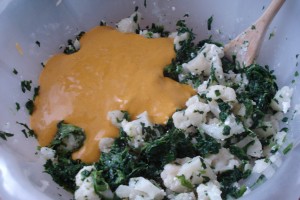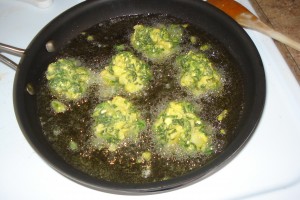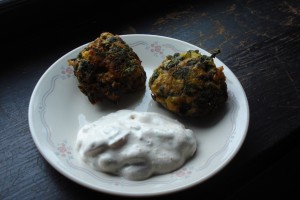Sometimes I set out in search of one particular type of recipe, but sometimes a recipe finds me instead. While on the hunt for something else, I stumbled upon this recipe and said, “Well, heck, I’ve got to book mark this one.” It very quickly thereafter made it onto my shopping list for a lazy Sunday of recipe experimentation:
SWEET POTATO KOFTA
 1 (40 oz) can medium sweet potatoes, rinsed thoroughly
1 (40 oz) can medium sweet potatoes, rinsed thoroughly
1/2 cup dry red lentils, cooked
1/4 cup minced dates
1/4 cup shredded coconut, toasted
2 tablespoons minced garlic
2 tablespoons ground ginger
1 jalapeno pepper, minced
1 teaspoon ground cumin
1/2 teaspoon toasted sesame seeds
2 tablespoons cilantro chutney
salt and pepper to taste
2 tablespoons cornstarch, optional
1/2 teaspoon baking powder
extra water, or an egg
MANGO RAITA (all ingredients to taste)
mango chutney
lime juice and/or zest
plain yogurt or sour cream
salt
black mustard seeds
Unless I need sweet potatoes (which are functionally the same thing as yams) to retain their shape (e.g. as fries or in cubes), I use canned because they are so cheap, easily available, and pretty much ready to use right out of the can. Problem is, they are often stored in syrup. Just make sure you rinse the potatoes very thoroughly to get all the extra sugar off.
Preheat oven to 400. Prepare all ingredients as indicated in the recipe list and then combine in a large bowl. I used electric egg beaters and they worked well for pulverizing the potatoes without pureeing the other ingredients. Add a little water, or an egg, if ingredients seem too dry. Form into roughly golf-ball sized kofta and arrange on a non-stick baking sheet. Bake until golden brown (check after about 20 minutes).
Meanwhile, prepare the mango raita by combining all the ingredients in desired proportions. If you’ve never made raita or don’t know what it is, the yogurt or sour cream is the primary ingredient of this condiment, the fruit or vegetable (in this case, mango chutney is used for ease of preparation), should be a secondary amount, and then more lightly on the seasonings to taste. I like a little runnier raita so that it’s good as a dip, but don’t add so much lime juice it gets too liquid-y.
One additional innovation I made with this recipe… the weekend after I made them, I decided to try some modifications to my pakora recipe, and ended up with a lot of pakora batter, so I battered and fried the leftover koftas. Definitely tasty either way.





